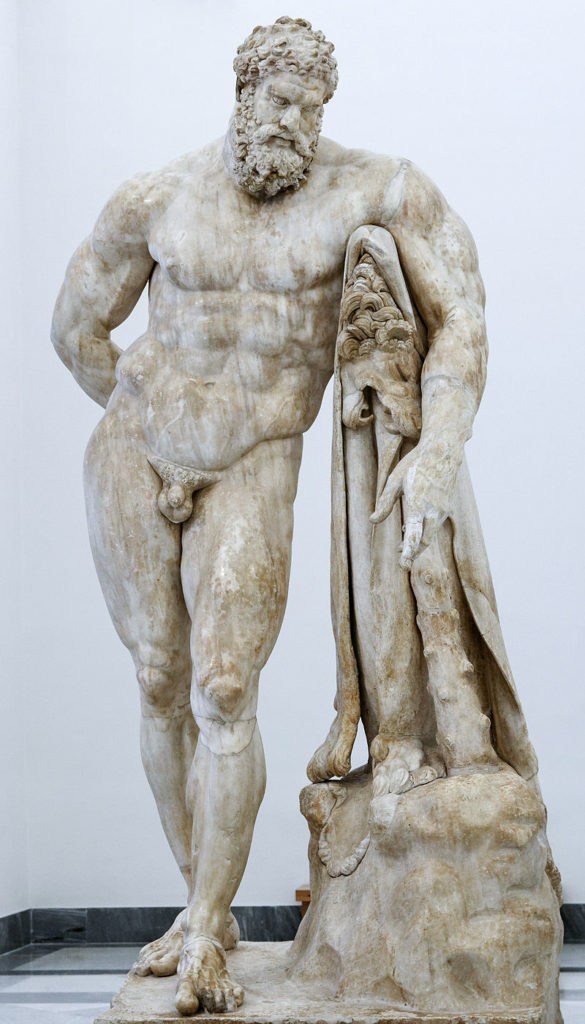Complaints about the risk and damages associated with unattainable beauty standards are frequent. Legitimate, these critics only recently started to unveil the harsh consequences such standards can have on men as well. Effects that range from the “unspoken steroid-taking epidemic” to the influence on male’s suicide and self-esteem.
Moving away from these one-sided perspectives, this article will take a step back to highlight both phenomena as two faces of the same coin. Indeed, beauty standards have never been attainable for either men or women, what changed is our modern unwillingness to accept our own limitations.
Lessons from the Greco-Roman mythology
Cornerstone of Max Webber’s sociology, the concept of “ideal-type” is crucial to analyse the question of beauty standards. In a nutshell, an ideal-type can be defined as an intellectual archetype produced by a culture and that can never be found in reality, but serves as a compass to guide individual’s efforts. For instance, societies produce male and female beauty standards that help individuals to know how to become attractive. Yet, these standards are only “ideal-types” meaning that, in reality, fully matching them is inherently impossible.
In other words, from this perspective, the existence of unattainable standards is neither surprising nor abnormal: it is a common feature shared by all cultures and societies. This does not mean that beauty ideals do not cause any psychological harm. However, the concept of ideal-type highlights that the problem does not stem from the existence of such standards, but rather from the way they are structured in modern societies.
In his book “La Barbarie Intérieure” (The Barbarity Inside), the French philosopher Jean-François Mattéi demonstrates that Greeks saw culture as a careful balancing act between the two pitfalls looming over mankind, the two faces of barbarism: vanitas and hubris.
According to Greek wisdom, any individual unable to control their internal chaos risks to fall victim to their bestial instincts and thus become a vain and mediocre person unable to strive for more. This is vanitas. But the chaos inside us also conveys the opposite risk of hubris: the rejection of the boundaries intrinsic to the human condition. Hubris makes us tempted to indulge in the irrational desire to subjugate the world to our own personal will.
Bulwark against the risk associated with our existence, the Greek culture was therefore a never-ending quest to achieve what Aristotle already referred to as the “Golden Middle Way”.
Consequently, the Greek ideal type of beauty was both an invitation to strive for beauty and a reminder to accept human boundaries, such as age and imperfections. In the context of classic Greek culture, this belief was transmitted through a series of myths and legends. This is best illustrated through the myth of Icarus who, discarding his father’s warnings, flew too high in the sky. Reaching the limits of the human’s realm, the wax of his wings melted, leading him to his fall and death.
Similarly, Greek myths about beauty act as warnings. The tale of Narcissus who died because he fell in love with his own reflection is the most famous example. However, the story of Psyche is even more eloquent. Unable to find a spouse, Psyche was so beautiful that crowds from the entire country came to gaze at her magnificence, so amazed that they even forgot to honour the real goddess of beauty and love: Aphrodite. Enamoured with Eros (Cupid in Roman mythology), Psyche is tricked by her sisters and Aphrodite. Losing the love of Eros who fly away from her, Psyche accepts Aphrodite’s punishment. Four gruesome trials that brings Psyche on the verge of despair, death and suicide. Finally, Psyche overcomes the difficulties, passes the test and, granted eternal life by Zeus, is reunited with Eros and becomes a symbol of eternal love.
As so many other myths, the story carries a clear warning: only true Gods could be so beautiful as to receive a cult and be admired by the entire land. Any woman considering herself too beautiful for any man or even more beautiful than Aphrodite herself would have to pay the price of her foolishness. Only after Psyche surrenders and submits herself to the goddess’s trials does she receive the reward associated with beauty: true love and a good spouse.
Aside from Psyche’s “happy-ending”, most Greek myths end as tragedies. The fate of these fallen heroes’ act as a warning: no mortal is invincible, not even Herakles (Hercules in roman mythology) or the great Achilles. Indeed, all ideal types of manliness suffer terrible fates: Achilles dies from Paris’s arrow, Theseus is banned from his city and even the all-mighty Herakles — probably the closest depiction of our contemporary male beauty standards we can find in ancient Greece — is killed by ruse.
Christianity prolonged this tradition. This is something best illustrated in the series of “Vanitas” that were painted during the renaissance. Echoing Greek’s wisdom, these paintings warned the spectator about the vacuity and ephemeral nature of all earthly things, including beauty.
From German nihilism to Marylin Monroe: the reign of the modern hubris
The sexual liberation and the liberalisation of society that took place in the 60’s profoundly changed the way we perceive these ideal types of beauty. While Greek heroes were both models to follow and warnings to be listened to, modern “heroes” are portrayed as regular people we should envy and copy.
This is especially visible in the context of the 60’s where the status of stardom held a sway that is barely conceivable nowadays. Living embodiment of beauty, Marylin Monroe shines as the modern Psyche, the object of a beauty-cult that grasped the entire planet and, in conformity to Greek’s warning, led to a downfall comparable to Icarus’ fate.
Contrary to Greek heroes, stars are no longer a warning against our inner desire to become gods. Instead, they are portrayed as commoners who climbed the social ladder to reach a god-like status, thanks to their popularity.
Instead of warning us about the damages caused by her drug-fuelled lifestyle, a beauty model from the 60s such as Edie Sedgwick gave away her “beauty standards”, while remaining conspicuously silent about her anorexia.
Similarly, Arnold Schwarzenegger remained mute about his abuse of steroids, until his health became so jeopardised that the lie was no longer believable. As the Greeks had warned us, divine beauty comes at a dear price for mortals.
To understand the root cause of such an evolution, one needs to understand that, contrastingly to the Greek ideal of self-limitation, modern culture was born with the ideal of infinite progress, unlimited human power and absolute will of the self.
Johan Gotlieb Fichte, German philosopher of the early XXth century, provides us with the best theoretical description of this mindset. To simplify, according to Fichte, the world is divided between the “I” and the “Not-I”. In this view, the constraints and rules imposed on human will should no longer be seen as a warning issued by gods to protect us from our own hubris. Instead, these laws are absurd, unfair and have no other origin than the arbitrariness of existence.
Fichte theorised what has now become the dominant mindset. As a result from such a worldview, heroes are no longer those whose tragic fates warn us about the risk associated with our internal chaos and with excesses. Instead, the hero is the rule-breaker, the one that can impose his will to an absurd world and an unfair society.
Female beauty models are thus constantly celebrated and encourage to embrace their freedom and sexuality against the oppressive rules of the patriarchal society. Similarly, males are enjoined to copy their beauty models through inspirational speeches, such as the one given by Schwarzenegger, where he invites listeners to “work their ass off” — while remaining silent on the fact his own success would have been impossible without performance-enhancing drugs.
Modernity gave birth to an ideology of absolute will of the self that progressively subjugated us to our own internal chaos, and turned us into ever desiring machines with no ability to refrain ourselves. There is a reason Marylin Monroe became such a cultural icon. This is because we all are Marylin. And Monroe is all of use, as proven by the multiplication of incredibly popular Instagram models — even though their fans are perfectly aware that their content they produce do not reflect reality at all.
No longer a warning against immoderation, beauty models act as an escape far from our daily lives.
Enjoined by our contemporary culture to “Be realistic, ask for the impossible” as “It is forbidden to forbid”, we are constantly bombarded with pictures of over-sexualised and incredibly gorgeous beings that are no longer urging us to accept our mortal condition, but to break society’s rules and compete with stars. Beings that, thanks to the wonder of modern technologies, have reached a level of beauty that would have made Aphrodite and Hercules ashamed of their bodies.
Both men and women of modern societies suffer from the hubris caused by this technology-fed and limitless delusion of grandeur.
The cure is known, simple and already perfectly coined by Nietzsche himself. We need to become Greeks again.


